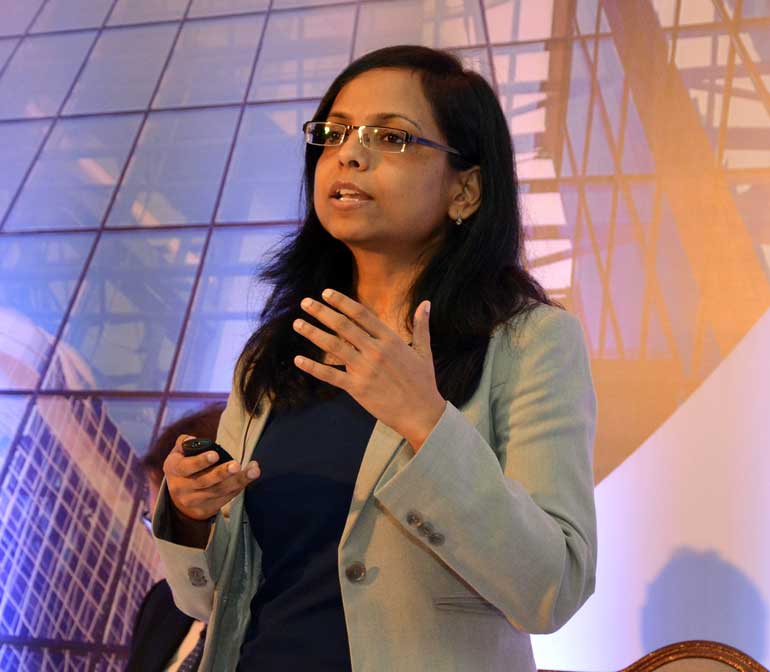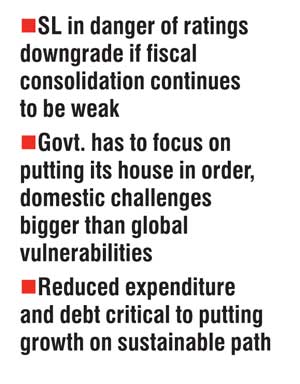Thursday Apr 10, 2025
Thursday Apr 10, 2025
Monday, 25 January 2016 00:00 - - {{hitsCtrl.values.hits}}

Standard Chartered Bank South Asia Economic Research Head Anubhuti Sahay - Pic by Upul Abayasekara

By Uditha Jayasinghe
Putting Sri Lanka’s fiscal consolidation in order has to be the foremost priority of the Government in 2016 if policymakers are to stave off a possible downgrading on the country’s sovereign rating, prevent overheating and put the economy on a sustainable path, according to top analysts.
A group of Standard Chartered Bank analysts presenting global, Asian and Sri Lankan prospects for the New Year unified the challenges before the country. Standard Chartered Bank’s South Asia and India Senior Economist Anubhuti Sahay presenting the island’s prospects noted there was a “more than 50% possibility” of a rating downgrade if the Government does not reduce debt, decrease the Budget deficit, improve monetary tightening and raise investment in the coming months.
Currently Standard & Poor’s credit rating for Sri Lanka stands at B+. Moody’s rating for Sri Lanka sovereign debt is B1. Fitch’s credit rating for Sri Lanka is BB-. In general, a credit rating is used by sovereign wealth funds, pension funds and other investors to gauge the credit worthiness of a country thus having a big impact on the country’s borrowing costs.
Prime Minister Ranil Wickremesinghe has already indicated the country is considering assistance from monetary institutions including the International Monetary Fund (IMF) and bilateral lending to boost revenue. He met with IMF Managing Director Christine Lagarde in Davos on the sidelines of the World Economic Forum. “While we are looking at challenges we should not forget the longer-term picture and that is if the policies taken in 2016 put the economy on the right path and put the country on a sustainable growth, inflation path that effectively will mean we will do well in the medium to longer term,” Sahay noted.
Macro vulnerabilities have increased in the economy during the past year, according to analysts. Sri Lanka underwent a fiscal consolidation between 2009 and 2013, showing a massive improvement where deficit numbers reduced from 7% of GDP to 5.4% of GDP but in 2015 there was a sharp rise of 6.5% driven by populist policies including public sector wages, exemptions on vehicle imports and tax cuts on fuel leading to the widening of deficit, she pointed out. While 2016 targets are better analysts are cautious of the 5.9% fiscal target because the revenue assumptions of the Government are seen as “overly optimistic” as such revenue spikes have not been seen over the past seven years.
“One of the ways the Government has met its deficit is to cut down on public investment. An excessive budget deficit will add to the Government’s public debt to GDP ratio. If the fiscal deficit is close to 6%-7% and the Government insists on maintaining a large deficit then public debt will increase and in the current environment where deflationary pressures are very strong, the risk is public debt growing at a much faster pace. Sri Lanka amongst its peers already has the highest public debt to GDP ratio….if it starts moving up it can mean a negative rating action in 2016,” she told a gathering of private sector representatives, diplomats and reporters.
The situation is not helped by increasing external vulnerabilities. Currently, Sri Lanka has sufficient reserves to cover just four months of imports and external debt to foreign exchange rate reserves has deteriorated, analysts went onto say. This is crucial as the Government has to repay an estimated $ 2 billion in loans during 2016. Sri Lanka also has huge funding needs on a monthly basis, which is seen in the trade deficit numbers. Falling global oil prices failed to benefit the trade deficit as those gains were largely offset by stronger consumption based imports. The significant drop in Foreign Direct Investment (FDI) has also adds to the uncertainty, Sahay pointed out.
“All these factors make us very cautious. GDP growth, as per Central Bank projections, looks good. During the last few years growth has been primarily driven by consumption that shows domestic momentum but in the case of Sri Lanka the reason it causes wariness is because consumption was boosted by public sector wage increases that came at fiscal cost, monetary easing, which led to more household credit is now at 22%. It clearly shows the economy is overheating and it needs to be brought back to a much more sustainable path.”
The biggest question for 2016 will be what the policymakers will do to address these issues. The Government would also have to increase taxes on specific goods to reduce import-based consumption patterns, she advocated. Fiscal consolidation would also call on officials to take a tough stance on exemptions, subsidies and non-productive expenditures as well as require measures focused on medium-term growth such as State-owned Enterprise reform and expanding the tax base. Efforts the Government has so far dragged its feet on. However, improving access in the European Union, India and US markets, which account for 70% of Sri Lanka’s exports, was also applauded by the analyst.
“Good headline growth matters but it has to be sustainable. Given the current situation we do think it is necessary for the Government or the Central Bank to make some monetary tightening, which discourages private credit takeoff for consumption purposes and a relook at Statutory Reserve Ratios. This year will remain very challenging for Sri Lanka but more than the external situation the domestic policy structure will matter more and is crucial to move the economy to a sustainable path.”